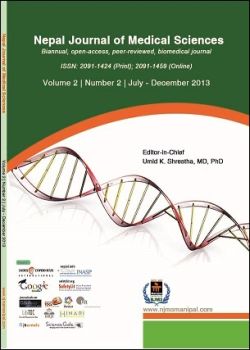Knowledge, Attitude and Practice regarding Cervical Cancer Screening Amongst Women visiting Tertiary Centre in Kathmandu, Nepal
DOI:
https://doi.org/10.3126/njms.v2i2.8941Keywords:
Attitudes, cancer screening tests, health knowledge, practice, uterine cervical neoplasmAbstract
Background: Cervical cancer is one of the commonest cancers in Nepal. Fortunately, it is preventable by detecting precancerous lesions and early invasive cancers by various screening tools. Screening can be possible if women are aware of the problem and if they have positive attitude .Therefore this study was conducted to find out about the knowledge, attitude and practice of cervical cancer in Nepalese women attending a tertiary level hospital in Nepal.
Methods: A cross-sectional questionnaire based study was conducted in gynaecological out patient department of Kathmandu Medical College from January to March 2011. Structured questionnaire was used. Demographic profile of women was noted and questions pertaining to knowledge, attitude and practice on screening for cervical cancer were asked.
Results: There were 105 respondents, of whom 65.7% had heard about cervical cancer. However, only 42.9% and 18.1% had knowledge about screening for cervical cancer and Pap smear test respectively. More than 85% of women had positive attitude towards screening but the uptake of Pap smear test in the respondents was only 10.5%. It was found that advancing age and longer duration of marriage were significantly associated with better knowledge, attitude and practice.
Conclusion: Knowledge and practice of the screening for cervical cancer was poor in gynaecological patients visiting a tertiary level hospital. However the attitude of women towards screening was positive.
Nepal Journal of Medical Sciences | Volume 02 | Number 02 | July-December 2013 | Page 85-90
Downloads
Downloads
Published
How to Cite
Issue
Section
License
Copyright © by Nepal Journal of Medical Sciences. The ideas and opinions expressed by authors of articles summarized, quoted, or published in full text in this Journal represents only opinions of authors and do not necessarily reflect the official policy of Nepal Journal of Medical Sciences or the institute with which the author(s) is (are) affiliated, unless so specified.




